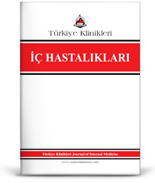Palliative care consists of communication, coordination, symptom control, continuity of care, caregiver support and end of life care. Nursing models provide nursing care by systematizing nursing practices. It is aimed to give care to the patient according to the nursing model based on life activities. Our case is a 32-year-old male with hypoxic brain and myocardial infarction. Nursing care was given with the diagnosis of under/over nutrition, risk of fluid-electrolyte imbalance, deterioration in gas exchange, ineffectiveness of respiratory functions, confusion, and deterioration in family process. The aim of nursing care is to evaluate the complications that may develop by providing care for the patient's problems and to eliminate the lack of information of the family. In our case, care was given for the nursing diagnoses mentioned. The care given had a positive effect on the quality of life of the patient.
Keywords: Palliative care; nursing care
Palyatif bakım; iletişim, koordinasyon, semptom kontrolü, bakımın sürekliliği, bakım veren desteği ve yaşam sonu bakımdan oluşmaktadır. Hemşirelik modelleri ise; hemşirelik uygulamalarını sistematize ederek hastaya bakım sunmaktadır. Olgumuza Yaşam Aktivitelerine Dayalı Hemşirelik Modeline göre bakım verilmesi amaçlanmıştır. Olgumuz 32 yaşında erkek hipoksik beyin ve miyokard infarktüsü tanılarıyla yatmaktadır. Olgumuza beden gereksiniminden az/fazla beslenme, sıvı-elektrolit dengesizliği riski, gaz değişiminde bozulma, solunum fonksiyonla- rında etkisizlik, konfüzyon, travma, düşme ve bası yarası riski, aile sürecinde bozulma tanılarıyla modele göre bakım verilmiştir. Hemşirenin bütüncül yaklaşımla planladığı bakımda amacı, hastanın mevcut sorunlarına yönelik bakım vererek gelişebilecek komplikasyonları değerlendirmek ve ailenin bilgi eksikliğini gidermektir. Olgumuzda belirttiğimiz hemşirelik tanılarına yönelik bakım verilmiştir. Olgumuza verilen bakımın hastanın yaşam kalitesi üzerine olumlu katkısı olmuştur.
Anahtar Kelimeler: Palyatif bakım; hemşirelik bakımı
- Akçiçek F, Akbulut F, Fadıloğlu ZÇ. Palyatif Bakım; Evde ve Hastanede Çalıştay Raporu. Ege Geriatri Derneği Yayınları: 1. 1. Baskı. İzmir: Meta Basım Matbaacılık Hizmetleri; 2013. p.1-46.
- Elçigil A. [Palliative care nursing]. Gülhane Tıp Derg. 2012;54:329-34.[Crossref]
- Köşgeroğlu N, Mert Boğa S. [Mental disabled persons' issues according to the Daily Life Activities Model (DLAM)]. Maltepe Üniversitesi Hemşirelik Bilim ve Sanatı Dergisi. 2011;4(1):148-54. https://www.researchgate.net/publication/322702435_Yasam_Aktivitelerine_Dayali_Hemsirelik_Modeli_YADHM'ne_Gore_Zihinsel_Engelli_Bireylerin_Sorunlari_ve_Hemsirelik_Mental_Disabled_Persons'_Issues_According_to_the_Daily_Life_Activities_Model_DLAM
- Roper N, Logan WW, Tierney AJ. The Roper-Logan-Tierney Method of Nursing: Based on Activities of Living. 1st ed. Edinburg: Elsevier Health Sciences; 2000. p.203.
- Açıkgöz G, İbrahimoğlu Ö. Preoperative and postoperative nursing care based on the model of daily living activities of a patient with type-a aortic dissection: a case report. Turk J Cardiovasc Nurs. 2019;10(22):87-95. https://jag.journalagent.com/kvhd/pdfs/KVHD_10_22_87_95.pdf
- Durmaz Akyol A. [Palliative care in patient with end stage renal disease]. Cumhuriyet Nurs J. 2013;2(1):31-41. http://docplayer.biz.tr/34530947-Son-donem-bobrek-yetmezligi-sdby-olan-hastada-palyatif-bakim.html
- Shalev A, Phongtankuel V, Kozlov E, Shen MJ, Adelman RD, Reid MC. Awareness and misperceptions of hospice and palliative care: a population-based survey study. Am J Hosp Palliat Care. 2018;35(3):431-9.[Crossref] [PubMed] [PMC]
- Rosansky SJ, Schell J, Shega J, Scherer J, Jacobs L, Couchoud C, et al. Treatment decisions for older adults with advanced chronic kidney disease. BMC Nephrol. 2017;18(1):200.[Crossref] [PubMed] [PMC]
- Campbell RT, Petrie MC, Jackson CE, Jhund PS, Wright A, Gardner RS, et al. Which patients with heart failure should receive specialist palliative care? Eur J Heart Fail. 2018;20(9):1338-47.[Crossref] [PubMed] [PMC]
- Meffert C, Hatami I, Xander C, Becker G. Palliative care needs in COPD patients with or without cancer: an epidemiological study. Eur Respir J. 2015;46(3):663-70.[Crossref] [PubMed]
- Steigleder T, Kollmar R, Ostgathe C. Palliative care for stroke patients and their families: barriers for implementation. Front Neurol. 2019;10:164.[Crossref] [PubMed] [PMC]
- Pesut B, Greig M. Resources for educating, training, and mentoring nurses and unregulated nursing care providers in palliative care: a review and expert consultation. J Palliat Med. 2018;21(S1):S50-6.[Crossref] [PubMed] [PMC]
- Thoonsen B, Engels Y, van Rijswijk E, Verhagen S, van Weel C, Groot M, et al. Early identification of palliative care patients in general practice: development of RADboud indicators for PAlliative Care Needs (RADPAC). Br J Gen Pract. 2012;62(602):e625-31.[Crossref] [PubMed] [PMC]
- Güdük Ö, Güdük Ö. [Evaluation of palliative care unit performance by topsis method]. Adıyaman Üni Sağlık Bilimleri Derg. 2017;3(2):511-27. https://www.researchgate.net/publication/325648978_PALYATIF_BAKIM_UNITELERI_PERFORMANSININ_TOPSIS_YONTEMI_ILE_DEGERLENDIRILMESI
- Flierman I, Nugteren IC, van Seben R, Buurman BM, Willems DL. How do hospital-based nurses and physicians identify the palliative phase in their patients and what difficulties exist? A qualitative interview study. BMC Palliat Care. 2019;18(1):54.[Crossref] [PubMed] [PMC]
- Gardiner C, Gott M, Ingleton C. Factors supporting good partnership working between generalist and specialist palliative care services: a systematic review. Br J Gen Pract. 2012;62(598):e353-62.[Crossref] [PubMed] [PMC]
- Eser U, Küçük ıG, Dilli UD, Öngel K. [Daytime patient care point of view of palliative patient relatives]. Klinik Tıp Aile Hekimliği Dergisi. 2018;10(2):31-4. https://dergipark.org.tr/tr/download/article-file/764101
- Boston P, Bruce A, Schreiber R. Existential suffering in the palliative care setting: an integrated literature review. J Pain Symptom Manage. 2011;41(3):604-18.[Crossref] [PubMed]
- Cassileth BR. Palliative care: progress, needs, and challenges. Isr J Health Policy Res. 2012;1(1):10.[Crossref] [PubMed] [PMC]
- Özkan S. Kronik Obstrüktif Akciğer Hastalığı'ında (KOAH) Palyatif ve Yaþam Sonu Bakımı. Selçuk Tıp Derg 2011;28(1):69-74.
- Zimmermann C, Swami N, Krzyzanowska M, Leighl N, Rydall A, Rodin G, et ol. Perceptions of palliative care among patients with advanced cancer and their caregivers. CMAJ. 2016;188(10):E217-27.[Crossref] [PubMed] [PMC]
- Torun N. Palliative care experiences of the patient family. Cukurova Med J. 2019;44(Suppl 1):358-65.[Crossref]







.: İşlem Listesi